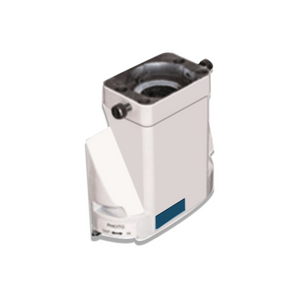- True trinocular image port for SM51 series microscope system, for connecting a microscope camera.
- Diameter opening for camera coupler is 36mm
- The top diameter for where the binocular head mounts onto measures 53mm at the smallest point.
- The bottom diameter for mounting onto the zoom body is 53mm.
Quick Overview
50/50 True-Trinocular. For SM5103 Series Parallel Multiple Power Stereo Microscope.
SM51035121 50/50 True-Trinocular Image Port
Stereo Image Port
| Image Port Switch Mode | 50/50 True-Trinocular |
| Surface Treatment | Spray Paint |
| Material | Metal |
| Color | White |
| Net Weight | 0.47kg (1.04lbs) |
| Applied Field | For SM5103 Series Parallel Multiple Power Stereo Microscope |
Technical Info
Instructions
Scope Body PartsClose Λ
| Nosepiece, also known as revolving nosepiece, can be mounted with several objective, and one of which in turn can be switched to the microscope optical axis for use. Nosepiece has different configurations, namely, single, triple, quadruple, and quintuple. Each objective has a ball buckle at its position to ensure that the objective is in the exact fixed position of the optical axis. Since any one set of objectives has the same parfocal distance, so when the objective is switched between high and low magnifications for observation, it is almost unnecessary to perform again the focusing operation. Nosepiece can be divided into two types, namely, inward nosepiece and outward nosepiece, depending on the positional direction. After switching, the tube of inward nosepiece is inclined to the side of the microscope body, which can save people's operating space and prevents it from hitting the lens. In general, after the objective is mounted onto the nosepiece, no special coaxial processing is required. If necessary, remove the nosepiece, and adjust the position of the end point screw on the dovetail rail behind the nosepiece. If the objective is still off-axis, adjust the optical axis of the condenser to match the optical axis center of the objective. In the use of microscope, if one set of objective cannot be parfocal, there are many reasons for the problem, but it may be that the nosepiece or the set of objective itself cannot guarantee parfocalness due to problems of processing precision. In this case, after confirming that the high and low magnifications of the objectives at both ends are in focus, adjust the objective of the middle magnification, and usually try to add a thin "shims" to correct. For normal switching of the objective, it is necessary to push the nosepiece instead of pushing and pulling the objective to prevent the objective and the nosepiece from deviating from the optical axis or loosening, so as to avoid image out of focus or damage. |
Image Port Switch ModeClose Λ
| The third eyepiece splitting in the trinocular microscope is to borrow one of the two sets of eyepiece optical paths as the photographic light path. The beam split prism or beam splitter can reflect part of the image light to the eyepiece, and part passes through to the third eyepiece photographic light path, such a trinocular microscope is called trinocular simultaneous imaging microscope, or true-trinocular. The beam split prism or beam splitter of the trinocular simultaneous imaging microscope or true-trinocular often has different splitting modes, such as 20/80 and 50/50, etc. Usually, the former is the luminous flux ratio of the eyepiece optical path, and the latter is the luminous flux ratio of the photographic optical path. The advantage of true-trinocular is that, the real three optical paths can be imaged at the same time, and are not affected by the simultaneous use of the eyepiece observation and the photographic optical path (display). The disadvantage is that, because of the reason of the splitting, the image light of the photography is only a part. In theory, the image effect will be affected, and the effect is more obvious in the binocular eyepiece observation. If viewed closely, one will find that the eyepiece of the light path is relatively dark. However, in the current optical design and materials, the impact on the actual work is not very big, especially in the observation of low magnification objective lens, it has basically no effect at all, and therefore used by many people. |
PackagingClose Λ
| After unpacking, carefully inspect the various random accessories and parts in the package to avoid omissions. In order to save space and ensure safety of components, some components will be placed outside the inner packaging box, so be careful of their inspection. For special packaging, it is generally after opening the box, all packaging boxes, protective foam, plastic bags should be kept for a period of time. If there is a problem during the return period, you can return or exchange the original. After the return period (usually 10-30 days, according to the manufacturer’s Instruction of Terms of Service), these packaging boxes may be disposed of if there is no problem. |
| Packing | |
| Packaging Type | Carton Packaging |
| Packaging Material | Corrugated Carton |
| Packaging Dimensions(1) | 31x22.5x36.5cm (12.205x8.858x14.370″) |
| Inner Packing Material | Plastic Bag |
| Ancillary Packaging Materials | Expanded Polystyrene |
| Gross Weight | 0.90kg (1.984lbs) |
| Minimum Packaging Quantity | 1pc |
| Transportation Carton | Carton Packaging |
| Transportation Carton Material | Corrugated Carton |
| Transportation Carton Dimensions(1) | 31x22.5x36.5cm (12.205x8.858x14.370″) |
| Total Gross Weight of Transportation(kilogram) | 0.90 |
| Total Gross Weight of Transportation(pound) | 1.98 |
| Quantity of One Transportation Carton | 1pc |









